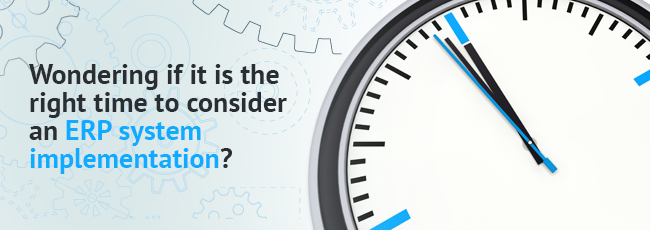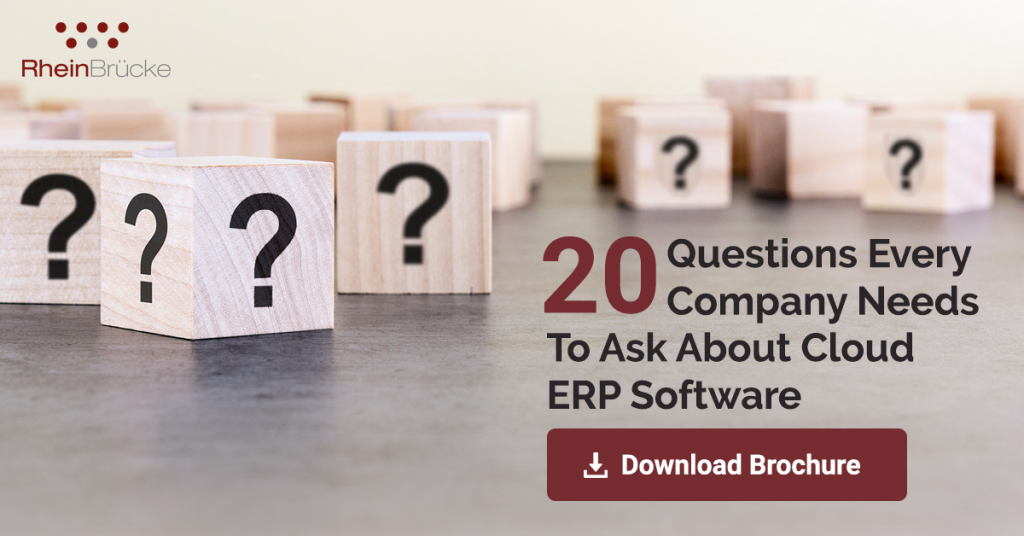
As an Intern at RheinBrücke, I came across the extensive first time implementation of ERP software by several SMB’s as this helps them improve efficiency, minimize errors in the business processes and enables back-end office function better. An ERP software provides integrated solutions to manage their business and automate the back-office operations related to finance, manufacturing, supply chain, service, Human resources, etc.
I was quite interested about ERP solutions and studied the concepts further and gathered a few inputs. A recent ERP report by Panaroma consulting says that, about 47% of organizations are in the process of deploying ERP software as it would help them to save their business’s most significant resource – TIME.
But how?
This blog will give you a better understanding on how an ERP can save your time, increase process efficiencies and how a “Successful ERP implementation” can be executed in your organization.
How an ERP saves time:
It integrates all facets of an operation – including product planning, development, manufacturing, sales and marketing into a single database, application and user interface. According to an Aberdeen report, companies which invested in an ERP system during 2015-2016 witnessed an increase in “on-time” delivery by 24%; which was a result of improved productivity, order tracking and decision-making.

- Everything in one place – According to a study by Mint Jutras, 58% of manufacturers report that they are doing lot of non-value added activities like double entry in multiple systems. An ERP can save your team from setting up users in multiple places, reducing errors, and giving the ability to look in all aspects of the organization, all from one source.
- Improving the way, we work – Finding a different perspective to old processes can pave the way for innovation and give an understanding on the unwanted and broken processes of the organization which need to be taken care of.
- Real Time information – Immediate access to data & information allows companies to take fact-based decisions.
- Collaboration – Projects and processes can be tracked as all the information is in one place. Managers and other departments can have better understanding of their colleagues’ work.
- Efficiency – Reducing manual effort, decreasing the lead time and giving more accurate information increases the overall efficiency of the organization.
Implementation is the key. According to Investopedia, LG electronics – the global giant having 82000 employees across 40 countries tried to harmonize its HR functions, the challenges were of a giant scale – lack of optimum resource, disengaged employees, challenges with decision making etc. Later they opted for an ERP system which proved to be beneficial as they minimized maintenance costs, real time reporting for higher management was enabled, money was saved as they used one single integrated system. Hence implementation of ERP and choosing the right implementation partner is the key for a company’s success.
Successful ERP implementation:
Detailing is the key – The First step is to understand the business process and system requirements of the company. The more specific the details we can obtain, the more details can be incorporated in the vendor’s proposal.
ERP of your own – Choosing a solution which already has the potential to address industry-specific processes and terms and regulation compliance will cut the need for costly modifications. According to Mint Jutras, 28% of the organizations reported of not being able to serve their customers as well as they aim to, due to the lack of functionality in their ERP systems. So, select an ERP which fits the specific requirements of your industry.
Also, plan for the future – According to Panaroma consulting, 23% of the organizations are unable to grow their business as quickly as they would want to because they lack the tools they need in their current ERP systems. So select a flexible ERP that can help you accommodate unforeseen future needs and changing business requirements.
Be efficient – Adopt the best practices and workflows of an ERP rather than trying to change the ERP to accommodate your organization’s old processes. Your organization will get maximum efficiency by adopting the ERP’s integral strategy for operational flow.
User experience – Choosing a user-friendly ERP can ease the implementation process, reduce the training period and increases the overall user experience.
Training is crucial – Training is the initial step in the process which makes sure the users are made to understand the new functions of the process that can aid them which will in turn benefit the company as a whole.
Communicate, collaborate and document – Communicate and collaborate very well with your ERP vendor. Documenting everything will make things a lot easier for analysis and change management.
Testing – Though the developer will test the application, it’s important that you test it and check whether all the requirements mentioned are incorporated in the ERP.
Conclusion:
From my understanding, your company can reap significant efficiency by implementing an ERP system. According to Aberdeen group, implementing an ERP system cut operational costs by 23% and administration costs by 22%. Midsized companies which have implemented ERP systems were able to support the change and grow operating margins by 21%. By using an ERP, you can achieve complete visibility into all the important processes.
Also, Monitoring employee progress will allow the management to be aware when an employee needs training and helps in keeping the team members on the same page. It also helps business owners gain a better understanding of the business performance which leads to minimization of error in decision making and execution process which will gradually increase the efficiency of their operations.




